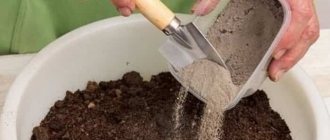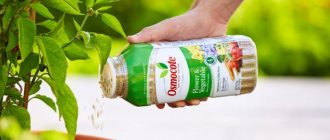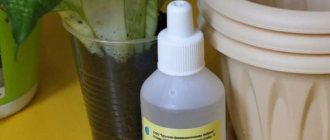The most common natural fertilizer among amateur gardeners is regular sugar. The lush decorative flowering of domestic plants thanks to sugar feeding is due to the main component - glucose. The fact is that it stimulates the process of photosynthesis, while at the same time being a source of energy that flowers need during active growth and development.
Can sugar be used as fertilizer?
Plants suffer most when the amount of sunlight and heat is limited. It is during the cold season that the development and growth of domestic flowers slows down. Due to the lack of light, the process of photosynthesis is complicated, and the plant is forced to consume its own hidden reserves.
Sugars are consumed first, so glucose is needed first for feeding.
If you properly organize watering of flowers with added sugar, they will grow healthy and strong, despite the coolness and lack of sunlight. BUT! It is also useful to arrange artificial lighting. This will create the illusion of sunny days.
The benefits of sweets
It is believed that feeding flowers with sugar is most necessary in winter, since at this time the sun is not often and the plants lack ultraviolet radiation. The same goes for greenery in dark rooms or planted in the shade. Sunlight is necessary for photosynthesis, but if it is not very active, then plants begin to use up their hidden reserves. The first thing that comes into play is sugar. This is why sweet fertilizers are so necessary in winter. Some hobbyists combine feeding home plants with sugar and installing lighting with a fluorescent lamp.
There are experiments that prove that plants that receive sugar supplements in the spring grow faster, become stronger and healthier. Such specimens bloom or sprout more often.
Benefits of Sugar for Plants
When the sugar additive gets into the ground, it breaks down into fructose and glucose. Fructose does not penetrate the plant structure, so it does not work well as a fertilizer. And glucose is absorbed by tissues and converted into:
- lipids;
- nucleins;
- proteins;
- starch;
- cellulose
The resulting energy is enough for plants to actively grow and develop.
In order for glucose to be better absorbed, flowers at home must be fed with yeast. When they break down, carbon dioxide is released, which promotes proper and complete absorption of glucose.
Indications for the use of glucose supplements
In the winter months, indoor flowers are especially in dire need of sweet fertilizer, as they suffer from a lack of light. A deficiency of ultraviolet radiation, which plays an important role in photosynthesis, forces plants to actively use internal resources, including their own sugars. The entry of glucose into their tissues triggers the formation of proteins and nucleic acids, cellulose and lipids, and starch. Sweet fertilizer strengthens plants, promoting increased immunity to diseases and insect attacks.
In spring, when home flowers are ready for active growth, sugar fertilizers carry a charge of health and strength.
Other indications for glucose feeding:
- slowdown in plant growth and development;
- thinning and stretching of stems, their drying out;
- unnatural change in foliage color - blanching, yellowing or blackening, spotting;
- shedding of leaves;
- delayed flowering or rapid fall of buds.
When is feeding needed?
The lack of vitamins in crops is determined by the following signs:
- slow growth;
- faded color of stems and leaves;
- thinning of shoots;
- long absence of flowering;
- change in leaf size downward;
- sickly appearance or leaf drop.
The plant needs feeding
When and what flowers should be fed?
Almost all house plants can be fed with sugar. However, flowering plants respond especially well to this fertilizer. The color of the foliage becomes more saturated, and the foliage itself becomes larger, while the bushes bloom longer than usual.
Sugar is great for:
- home roses;
- succulents, especially cacti;
- large crops: palms and ficus.
You should immediately “pamper” the flowers with glucose if:
- the shoots became thinner and more elongated;
- the bush grows more slowly;
- the size of the leaves has decreased significantly;
- the color of foliage and shoots has become faded and less impressive;
- flowering crops have ceased to delight with lush flowering;
- the leaves have turned yellow;
- the plants began to “get sick” often.
Ginger seeds for growing at home all year round (advertising)
Rules for breeding and watering
Sugar is used both for watering plants and for spraying on leaves. To prepare the mixture you need 1 tbsp. l. Dissolve sugar in 1 liter of liquid. For foliar feeding, this solution is diluted with water in a ratio of 1:2.
Sometimes flower lovers simply sprinkle sugar on the soil and water generously. In this case, fertilizer is applied in a proportion of 1 tsp. (without slide) for a pot diameter of 10 cm. Increasing the surface requires an additional 0.5 tsp for every 20 cm. sweet fertilizer.
If the diameter of the pot is less than 10 cm, 0.5 teaspoon per 1 liter of water is enough. In this case, you should not sprinkle granulated sugar on the ground, because the fertilizer will be absorbed into the soil more slowly, and there is a risk of mold and midges appearing on the surface.
Water should be taken that has settled, as for regular irrigation.
In order not to harm the plant, after the first feeding you should carefully monitor the reaction of the flower. If it looks healthy and blooming, then this fertilizer is suitable for it. If there is a negative reaction, you need to find another suitable option.
Combination with yeast
Yeast is used to improve glucose absorption. When they break down, carbon dioxide is formed.
The sweet yeast mixture is prepared as follows: 1 tsp. sugar is mixed with 1 g of dry yeast, diluted in 1 liter of water. The solution is consumed at the rate of 100 ml per 1 kg of soil.
This type of feeding of indoor plants cannot be done often; once a season is enough.
If you use yeast in large quantities, they absorb potassium and calcium from the soil, which will immediately affect the condition of the crop.
You can compensate for the lack of carbon dioxide without yeast by loosening the soil.
The procedure is performed every week. Two days before manipulation, the plant should be watered with plain water so that the soil is not excessively wet or dry.
After loosening, the flower will receive an influx of carbon dioxide and will be able to better absorb glucose.
Adding Ash
Experienced gardeners add wood ash along with this additive - 5 g per 1 liter of water.
But note that some plants do not tolerate ash well. These include azalea, calla lilies, anthurium, gardenia, and cypress. These flowers love acidic soil, and ash alkalizes it.
Fertilizing flowers for good growth and flowering is done with sugar
Flowers are the decoration of life.
This is a bright element of the interior and a wonderful gift for a woman. Many people cannot imagine life without indoor plants. Watering and feeding these lovely green spaces is a pleasant outlet after a working day or an interesting hobby. And they, in turn, thank their owners with their beauty and pleasant aroma. Even when there is a snowstorm and blizzard outside, spring can reign in your house, buds swell and fresh shoots grow. However, caring for indoor plants is not as easy as it might seem at first glance. Some people think that you just need to water your house flowers regularly. But in pots for green spaces there is too little space, and, accordingly, there is a lack of nutrients that greens absorb from the soil. In order for indoor plants to be healthy, strong and give flowers to their owners, they need help.
It’s rare that a summer resident gets along without fertilizers on his plot, but at home they are often forgotten. But in vain. Due to the fact that bushes in pots have a limited feeding area, they must be periodically replanted in a fresh nutrient substrate and fertilized in the ground. Even if the pot is large and spacious, the plant will deplete the soil's resources over time. And after a couple of months the plant again needs feeding. Organic and mineral fertilizers can be purchased in specialized stores for impressive sums of money, or you can make them yourself, using only what you have on hand.
Some home flower lovers believe that replanting or fertilizing once every six months or even once a year is enough, but they are seriously mistaken. Minerals from the soil are depleted in just two months, after which another fertilizing is necessary. A particularly acute lack of vitamins is observed in indoor plants during rapid growth or flowering. And in a warm apartment this happens not only in the spring. With proper care, buds or buds can appear in any season.
If you see that the flowers are growing slowly, have become weak, the leaves are small, colorless, covered in spots, have begun to dry out, or simply do not want to bloom, things are bad. It is better, of course, not to bring the plants to this state, but if this does happen, you need to help your green charges and treat them with something sweet. And this is not a joke, sugar is one of the most popular fertilizers for indoor plants and other flowers. This is largely due to the fact that white fertilizers can be found in any home, in the kitchen of every good housewife. But the benefits of sugar are irrefutable and have long been confirmed by numerous studies and experiments.
How often to water flowers with sugar
You need to water the plant properly. High soil moisture can harm the crop: spots appear on the leaves, stems lose strength. If there is an excess of sugar or water, the roots rot and the plant dies. Glucose can cause insects to appear, which is also harmful to the flower.
Watering with sugar once every 1-2 months is considered normal.
Some gardeners are confident that fertilizing should be done every week, but skeptics refute this opinion, believing that it is better not to top up than to overfill. And there is some truth in this, because sugar in large quantities can become poisonous to plants.
Do not forget that irregular feeding also affects the condition of the flower. A one-time sprinkling of sugar will only have a temporary effect, and if the procedure is not repeated, the problems will return again.
The first time fertilizer is applied 2 months after planting, when the plant gets stronger and gets used to new conditions.
First, water indoor flowers with plain water, and then give a small amount of sugar mixture. For diseased crops, the concentration of the solution is halved.
Basic mistakes
When using sugar fertilizers, novice flower growers may unknowingly make mistakes that, instead of being beneficial, will seriously harm indoor flowers. Most often such mistakes happen.
- Glucose overdose due to too frequent watering with sugar solution . Excess glucose inhibits plant development, possibly causing root rot and death. It is recommended to water flowers with sweet water no more than once a month.
- Violation of the feeding schedule . Only the systematic addition of a sugar solution will bring visible results, since the beneficial effect of sugar is temporary. To prolong it, you need to feed the plants in a timely manner.
- Incorrect ratio of components for flowering crops and for decorative deciduous crops. Often, beginning gardeners are at a loss as to why the plant “doesn’t want” to bloom despite good growth, many shoots and a lush green crown, but it’s all about incorrectly chosen feeding ratios.
Natural plant nutrition using folk remedies is a worthy, environmentally friendly alternative to industrial types. Not all fertilizers sold in modern garden centers are guaranteed to be safe. Of course, you should not assume that sugar supplements are a panacea for all ills. They cannot completely replace all fertilizers, but only promote the absorption of nutrients. This is only one small link in the chain of comprehensive care for growing beautiful flowering and decorative foliage plants.
Tips for feeding flowers with sugar are described in the following video.
Features of application
Sugar can be replaced with pharmaceutical glucose. To do this, dissolve 2 tablets in 1 liter of warm water.
When spraying the prepared solution, the likelihood of mold should be taken into account, therefore, in addition to glucose, you need to treat the soil with Baikal EM-1 or Vostok EM-1. These products will protect the plant from unpleasant consequences.
Refined sugar can replace regular granulated sugar.
Phalaenopsis love sugar compresses. To prepare the lotion, dry wipes or clean cotton cloth are soaked in a sweet spray solution and placed on the leaves.
After 20-30 minutes, the compress can be removed. If you don’t have time for lotions, then just wipe the leaves with a cotton pad soaked in the solution.
Crassula (popularly the money tree) often lacks moisture in the room. To do this, its leaves are sprayed with sugar fertilizer, which attracts the missing liquid.
House flowers in pots, even with proper fertilization, must be periodically replanted in new soil. In this regard, it is worth knowing that the plant needs to be watered with a sugar solution 2 months after the procedure.
If a crop does not take root well in a new place, then fertilizing is postponed for a longer time. There is no need to rush; you need to let the root structure take root in the substrate.
In advanced cases, injections into the flower trunk are recommended. But this is done in a serious condition, when other methods are ineffective. It is dangerous to let the plant reach this point: it may die without waiting for help.
Cocktail of sweetness and energy
You can simply pour sugar into a pot of flowers (one teaspoon is enough), and then add clean water. The solution is not only sweet, but also healthy.
As for the frequency of applying such fertilizing, there are no clear recipes, instructions or recommendations. Some recommend using fertilizers until positive results are achieved, others advise limiting yourself to applying one dora for 2-3 months. The main rule is not to overdo it, as this can provoke the formation of mold and even rot.
Using sugar as fertilizer in the garden
Fertilizing with sugar is carried out not only for indoor, but also for garden flowers. This helps the plant strengthen its root system, increase the growth of healthy shoots and the flowering period.
The solution for the garden is prepared as follows: dissolve 1 tbsp in 2 liters of boiling water. l. sugar and yeast.
After mixing the fertilizer, the container is left in a warm place for 7 days. 200 g of the infused mixture is mixed with 10 liters of water and fertilized with vegetables.
You can apply fertilizer in the garden once a month.
The history of the use of natural and healthy sweet dishes in crop production
History is silent about who first came up with the idea of feeding flowers with sugar. What is known is that many families passed this advice down from generation to generation.
And in the twentieth century, this folk remedy received scientific justification and recognition in the most authoritative circles of biologists.
In 1907, Lyubimenko investigated the ability of the root system to absorb sugars on its own, without the influence of any microorganisms. The world-famous scientist Michurin injected sugar directly into the tissues of green experimental subjects. Other experimenters have successfully grown greenery, including ferns and algae, without any exposure to sunlight at all, simply by fertilizing it with sugar. Thus, it was proven that it is the sweet solution that can compensate for the lack of light in a certain way.
Expert opinion
Fertilize indoor and garden crops with water and sugar. If you follow the rules of watering, the plants acquire a healthy appearance, as they receive all the necessary vitamins from broken down glucose. When watering, it is important to normalize the volume and frequency of fertilizer, since an excess can provoke the death of the species.
If you use ready-made pharmacy glucose as a basis, then you should additionally take care of the soil by treating it with EM preparations (the use of effective microorganisms) to reduce the risk of mold.
Methods for preparing fertilizer
There are several ways you can apply sweet cocktail to your plants.
- Scattering on the surface of the ground in a pot . This is the simplest option for feeding flowers with sugar. After this, the soil is watered with water in which yeast or EM preparation is dissolved.
- Using a sugar solution for watering . Sugar-yeast irrigation is carried out once in winter, spring and summer. More frequent use can cause harm by causing mold and mildew to grow. Often elements such as calcium and potassium are added to irrigation water. They are found in wood ash.
- Spraying foliage with sweet water . For dilution, choose pure glucose tablets, which are sold in all pharmacies. It is more effective in this case. One or two tablets are dissolved in a liter of water, after which the leaves are treated or special compresses are made by applying moistened wipes.
- Glucose injections into the trunk . In rare advanced cases, a weak glucose solution can be injected directly into the plant trunk.
One of the universal fertilizers, which can be used not only for indoor plants, but also to increase the yield of garden crops, is the BioGrow biofertilizer. This is a drug that has proven itself to be a highly effective revitalizing agent, as a result of which plants begin to develop noticeably faster, the green part is strengthened, and the flower’s resistance to fungal infections increases. find out more information and purchase the universal biofertilizer “BioGrow” HERE .
The frequency of sweet fertilizing depends on factors such as:
- plant type;
- state of the flower;
- nutritional value of the soil in the flowerpot.
Precautionary measures
Despite the large number of advantages, feeding with sugar also has disadvantages. I noticed these:
- Not all plants respond positively to glucose. For example, ficus, cacti, roses, and succulents respond with active growth and abundant flowering. While orchids and other exotics need to be fed with caution.
- The appearance of mold and fungus gnats. If there is an excess of the substance, mold may form on the soil surface. And with an excess of moisture - fungus gnats.
I advise you to carefully observe the dosage of fertilizing and adhere to the application schedule. It is better to underfeed the plant and gradually restore the lack of nutrients than to overfeed. This can cause the death of your favorite flower.
I recommend applying fertilizers only for healthy plants. If signs of disease or damage by insect pests are found, you need to get rid of them.
Maintain proportions. Be careful with diseased flowers.
If the flower responded positively to feeding: it activated growth, new leaves and buds began to appear, the leaves acquired a healthy appearance, then the action was carried out correctly.
Sugar-based fertilizers are one of my favorite fertilizers. It is inexpensive, and the flowers take on a healthy and beautiful appearance.











